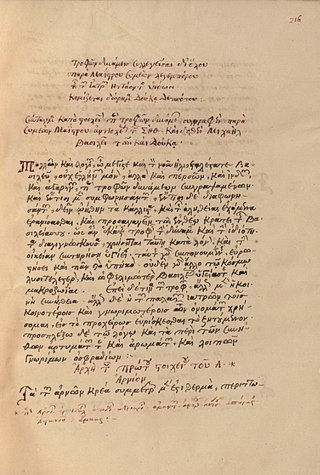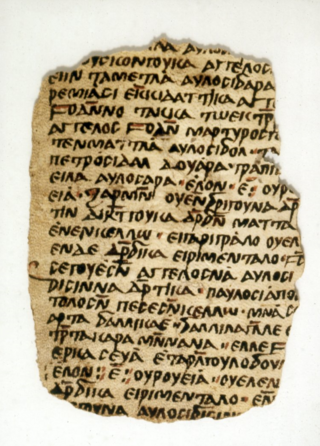Related Research Articles

John Chrysostom was an important Early Church Father who served as archbishop of Constantinople. He is known for his preaching and public speaking, his denunciation of abuse of authority by both ecclesiastical and political leaders, his Divine Liturgy of Saint John Chrysostom, and his ascetic sensibilities. The epithet Χρυσόστομος means "golden-mouthed" in Greek and denotes his celebrated eloquence. Chrysostom was among the most prolific authors in the early Christian Church.

The Vulgate, sometimes referred to as the Latin Vulgate, is a late-4th-century Latin translation of the Bible.

The Corpus JurisCivilis is the modern name for a collection of fundamental works in jurisprudence, enacted from 529 to 534 by order of Byzantine Emperor Justinian I. It is also sometimes referred to metonymically after one of its parts, the Code of Justinian.
Nonnus of Panopolis was the most notable Greek epic poet of the Imperial Roman era. He was a native of Panopolis (Akhmim) in the Egyptian Thebaid and probably lived in the 5th century CE. He is known as the composer of the Dionysiaca, an epic tale of the god Dionysus, and of the Metabole, a paraphrase of the Gospel of John. The epic Dionysiaca describes the life of Dionysus, his expedition to India, and his triumphant return. It was written in Homeric Greek and in dactylic hexameter, and it consists of 48 books at 20,426 lines.

Theophylact was a Byzantine Archbishop of Ohrid and commentator on the Bible.

Dom Bernard de Montfaucon, O.S.B. was a French Benedictine monk of the Congregation of Saint Maur. He was an astute scholar who founded the discipline of palaeography, as well as being an editor of works of the Fathers of the Church. He is regarded as one of the founders of the modern discipline of archaeology.

John IV, also known as John Nesteutes, was the 33rd bishop or Patriarch of Constantinople. He was the first to assume the title Ecumenical Patriarch. He is regarded as a saint by the Eastern Orthodox Church which holds a feast on September 2.
Nemesius of Emesa was a Christian philosopher, and the author of a treatise Περὶ φύσεως ἀνθρώπου or De natura hominis. According to the title of his book, he was the Bishop of Emesa. His book is an attempt to compile a system of anthropology from the standpoint of Christian philosophy; it was very influential in later Greek, Arabic and Christian thought.

The Euchologion is one of the chief liturgical books of the Eastern Orthodox and Byzantine Catholic churches, containing the portions of the services which are said by the bishop, priest, or deacon. The Euchologion roughly corresponds to a combination of the missal, ritual, and pontifical as they are used in Latin liturgical rites. There are several different volumes of the book in use.

Latin translations of the 12th century were spurred by a major search by European scholars for new learning unavailable in western Europe at the time; their search led them to areas of southern Europe, particularly in central Spain and Sicily, which recently had come under Christian rule following their reconquest in the late 11th century. These areas had been under Muslim rule for a considerable time, and still had substantial Arabic-speaking populations to support their search. The combination of this accumulated knowledge and the substantial numbers of Arabic-speaking scholars there made these areas intellectually attractive, as well as culturally and politically accessible to Latin scholars. A typical story is that of Gerard of Cremona, who is said to have made his way to Toledo, well after its reconquest by Christians in 1085, because he:
arrived at a knowledge of each part of [philosophy] according to the study of the Latins, nevertheless, because of his love for the Almagest, which he did not find at all amongst the Latins, he made his way to Toledo, where seeing an abundance of books in Arabic on every subject, and pitying the poverty he had experienced among the Latins concerning these subjects, out of his desire to translate he thoroughly learnt the Arabic language.

Symeon Seth was a Byzantine scientist, translator and official under Emperor Michael VII Doukas. He is often said to have been Jewish, but there is no evidence of this. He wrote four original works in Greek and translated one from Arabic.

Baroccianus is an adjective applied to manuscripts indicating an origin in the Baroccianum, a Venetian collection assembled by the humanist Francesco Barozzi (Barocius). A large part of that collection was sold after the death of Iacopo Barozzi or Barocci (1562–1617), nephew and heir to Francesco; and the purchase by William Herbert, 3rd Earl of Pembroke led in turn to his donation in 1629 of a substantial collection of Greek manuscripts from the Baroccianum to the Bodleian Library. The designation Codex Baroccianus followed by a number is an indication that a manuscript is in the Bodleian Catalogue and has its provenance in this donation.
Adversus Judaeos are a series of fourth century homilies by Saint John Chrysostom directed to members of the church of Antioch of his time, who continued to observe Jewish feasts and fasts. Critical of this, he cast Judaism and the synagogues in his city in a critical and negative light.
Severian, Bishop of Gabala in Syria, was a popular preacher in Constantinople from around 400 until 404. He became the enemy of John Chrysostom and helped condemn him at the Synod of the Oak.
Anianusof Celeda was the deacon of a church at a place called Celeda in the early fifth century and a supporter of Pelagius. It is not known where Celeda was: candidates include Pannonia, Northern Italy, Campania, Syria, and Cyrenaica.
John Sarrazin, also known as Johannes Sarracenus, John the Sarracen or John Sarrazen, was a twelfth-century scholar. He is known only from his translation of the writings of Pseudo-Dionysius from Greek into Latin.

Pseudo-Chrysostom is the designation used for the anonymous authors of texts falsely or erroneously attributed to John Chrysostom. Most such works are sermons, since more than 500 of John's actual sermons survive.
Codex Sinaiticus Rescriptus, mostly originating in Saint Catherine's Monastery, Sinai from Sin. Georg. 34; Tsagareli 81, is an accumulation of nineteen Christian Palestinian Aramaic palimpsest manuscripts containing Old Testament, Gospel and Epistles pericopes of diverse Lectionaries, among them two witnesses of the Old Jerusalem Lectionary, various unidentified homilies and two by John Chrysostom, hagiographic texts as the Life of Pachomios, the Martyrdom of Philemon Martyrs, and the Catecheses by Cyril of Jerusalem. The palimpsests manuscripts are recycled parchment material that were erased and reused by the tenth century Georgian scribe Ioane-Zosime for overwriting them with homilies and a Iadgari. Part of the parchment leaves had been brought by him from the Monastery of Saint Sabas, south of Jerusalem in the Kidron Valley, when he moved to St Catherine's Monastery and became there librarian. In the nineteenth century most of the codex was removed from the monastery at two periods. C. Tischendorf took two thirds in 1855 and 1857 with the Codex Sinaiticus to St Peterburg and handed it over to the Imperial Library, now the National Library of Russia, and the remaining third left on a clandestine route [so-called collection of Dr Friedrich Grote (1862-1922)] and found its way into various European and later also into US collections, at present in a Norwegian collection. From the New Finds of 1975 in the Monastery of Saint Catherine missing folios of some of the underlying manuscripts could be retrieved, with one connected to Princeton, Garrett MS 24.
References
- 1 2 One or more of the preceding sentences incorporates text from a publication now in the public domain : Chisholm, Hugh, ed. (1911). "Burgundio". Encyclopædia Britannica . Vol. 4 (11th ed.). Cambridge University Press. p. 820.
- ↑ H. Fitting, "Bernardus Cremonensis und die lateinische Übersetzung des Griechischen in den Digesten" in Sitzungsberichte ... Berlin (1894) pp. 813-820.
- ↑ Wright, George (August 13, 2006). Religion, Politics and Thomas Hobbes. International Archives of the History of Ideas Archives internationales d'histoire des idées. Vol. 195. Springer. p. 85. ISBN 9781402044687. OCLC 318388506.
- ↑ McGrath, Alister E. (September 16, 2016). Christian Theology: An Introduction. John Wiley & Sons. p. 30. ISBN 9781118869574. OCLC 1014020775.
- ↑ Μ. Morani, "ΙΙ manoscritto Chigiano di Nemesio" in Rendiconti dell'Istituto Lombardo vol. 105 (1871) pp. 621-635.
- ↑ R. J. Durling, Galenus latinus, vol. I: Burgundio of Pisa's Translation of Galen's ΠΕΡΙ ΚPACΕΩΝ "De complexionibus" Berlin; New York 1976.
- ↑ Francesco Buonamici, "Liber de vindemiis a Domino Burgundione Pisano de Graeco in Latinum fideliter translatus" in Annali delle Università Toscane vol. 28 (1908), memoria 3, pp. 1-29
- ↑ F. Bossier, “L’élaboration du vocabulaire philosophique chez Burgundio de Pise,” in Aux origins du lexique philosophique européen. L’influence de la latinitas. Actes du Colloque international organisé à Rome (Academia Belgica, 23-25 mai, 1996), ed. J. Hamesse, (Louvain-la-Neuve, 1997), pp.81-116.